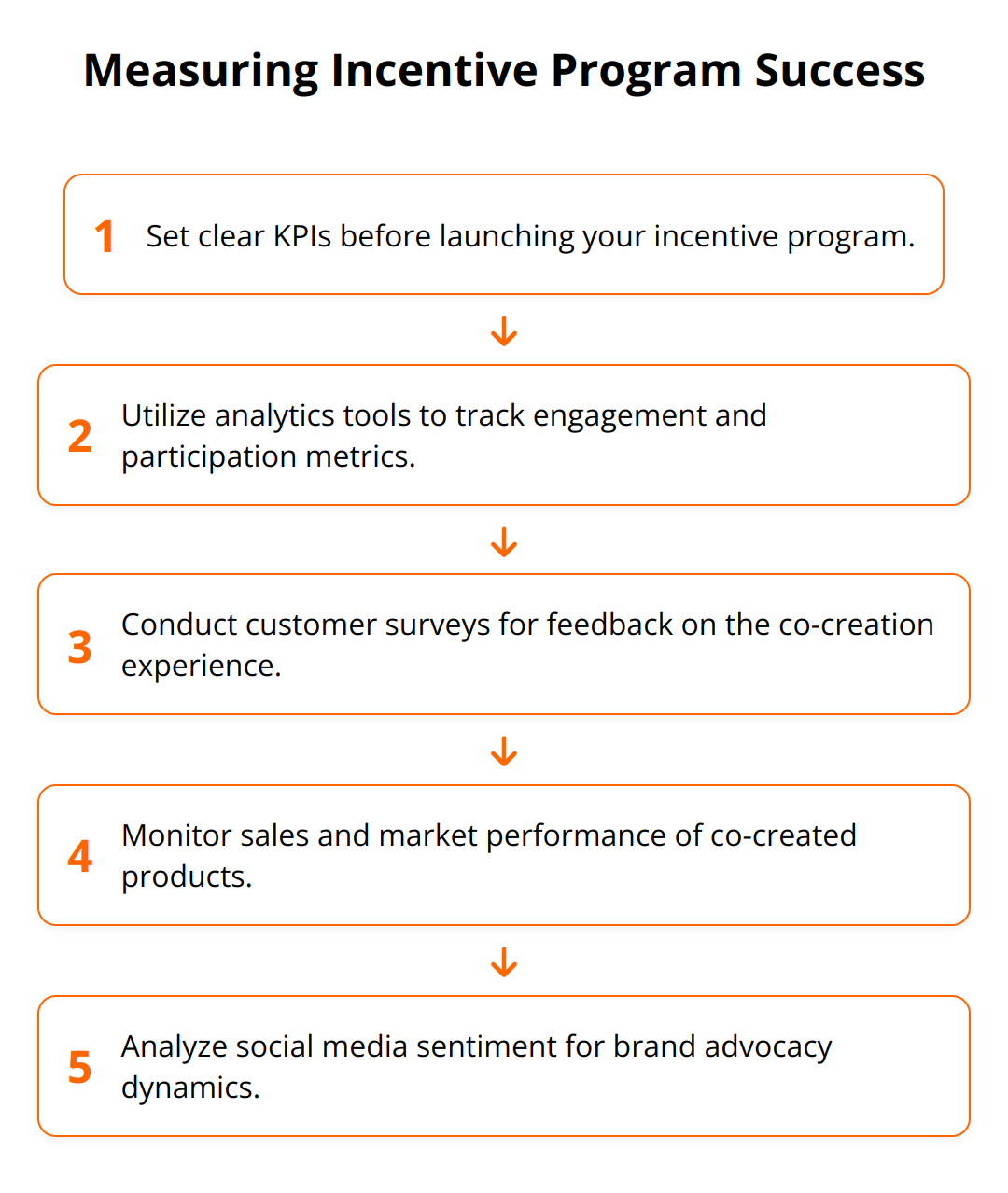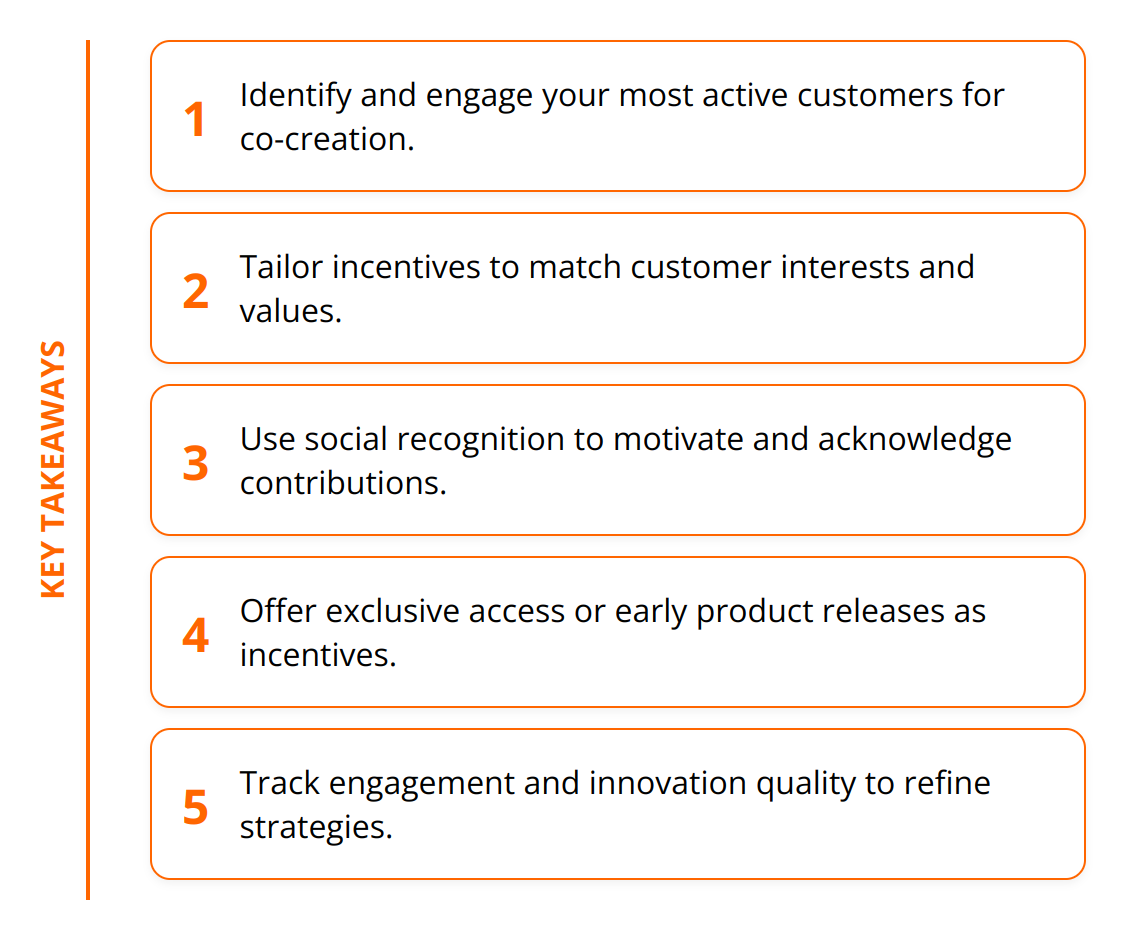
We at Reward the World have seen firsthand the transformative power of engaging customers directly in the creation process. Co-creation is more than a buzzword; it’s a strategic approach that aligns with consumer desires for deeper involvement with the brands they love. Through real-world examples and tangible data, this post: Why Incentives for Customer Co-Creation Are Effective, explores why offering incentives for customer co-creation not only boosts participation rates but also fosters innovation and strengthens loyalty. Dive into the reasons incentives are a game-changer in co-creation efforts.
Customer Co-Creation Works
Engaging customers in the co-creation process is not just about making them feel valued; it’s a strategy that leads to real results. Companies that understand the importance of this collaboration are reaping the benefits in terms of innovation, customer loyalty, and market share. Let’s break down why this approach is effective and how it can be implemented successfully.
The Importance of Customer Involvement
At its core, co-creation revolves around bringing customers into the development process of new products or services. This is more than just gathering feedback; it’s about active participation and collaboration. The logic is straightforward: who better to tell you what your customers want than the customers themselves? It’s a proactive approach to innovation, ensuring products meet actual needs and preferences, thus reducing market failure rates.

Boosting Participation Through Incentives
One of the main challenges in co-creation is motivating customers to participate actively. Here, incentives play a pivotal role. Whether it’s access to exclusive products, financial rewards, or public recognition, incentives can significantly drive up participation rates. The key is to align incentives with what your customers value the most. A clear understanding of your target audience is essential for designing an attractive incentive package.

Real-World Successes
Several brands have mastered the art of co-creation, turning their customers into avid collaborators. For instance, LEGO’s Ideas platform allows fans to submit their own designs for new sets, with successful submissions being turned into commercially available products. Not only does this initiative generate fresh ideas, but it also fosters a strong sense of community and loyalty among LEGO enthusiasts. Such examples underscore the potential of co-creation to transform customer engagement and product innovation.
Implementing Co-Creation in Your Strategy
Here are actionable steps for incorporating co-creation into your business strategy:
- Identify Your Community: Know who your most engaged customers are. These are your prime candidates for co-creation.
- Set Clear Objectives: Define what you want to achieve through co-creation, whether it’s product innovation, customer engagement, or market research.
- Design Attractive Incentives: Tailor your incentives to match the interests and values of your customer base. Remember, one size does not fit all.
- Facilitate Collaboration: Provide platforms or forums where customers can easily share their ideas, feedback, and collaborate with one another and with your team.
- Acknowledge Contributions: Show appreciation for participant contributions, not just through rewards but also by implementing their ideas and publicly recognizing their input.
Businesses that are serious about innovation and customer satisfaction cannot afford to overlook the power of customer co-creation. By inviting customers into the creation process and rewarding their contributions, companies can develop products that better meet consumer needs, engender loyalty, and stay ahead of the competition. The success stories of co-creation initiatives demonstrate that when it comes to innovation, two heads (or a few thousand) are indeed better than one.
Motivating Co-Creation with Incentives
Incentives can turn casual customers into active co-creators, significantly enhancing product development and customer engagement. To effectively motivate participation in co-creation projects, businesses must offer rewards that resonate with their audience’s interests and values. Here, we explore practical nuances around financial rewards, social recognition, and exclusive experiences. These incentives not only boost participation but also strengthen customer relationships and loyalty.

Financial Rewards and Discounts
Customers often perceive financial rewards as direct value for their efforts. Offering cash rewards, discounts, or point-based systems that can be redeemed for products or services can be powerful motivators. However, the success of financial incentives hinges on their perceived value. A minor discount might not cut it, but substantial savings or lucrative cash rewards could.
For instance, companies can implement a tiered rewards system where customers earn more as they contribute more valuable ideas. This approach ensures that your most active participants feel adequately rewarded for their high-value contributions.
Recognition and Social Standing
Humans inherently seek social recognition and status. Publicly acknowledging contributors not only satisfies this need but also propels others to participate. Highlighting customer contributions in newsletters, social media, or dedicated sections on your website can serve as powerful motivation. It’s a way to say, “We see you, we appreciate you.”
Organizing community events or competitions where customers can showcase their contributions and ideas fosters a sense of community and competition. Recognizing top contributors with titles or badges can also incentivize participation through a gamified experience.
Exclusive Access and Early Product Releases
Offering exclusive access to products or services before they hit the market is another effective incentive. Early access makes customers feel privileged and valued, enhancing their loyalty and connection to your brand. It’s a transparent way of saying, “Your contributions mean a lot to us.”
In addition, exclusive access can also mean involving customers in beta testing groups or giving them the opportunity to attend special events. This not only provides them with a sense of ownership over the end product but also generates invaluable feedback during the development phase.
Tailoring Incentives to Your Audience
Understanding your customer base is crucial for designing an effective incentive strategy. Here are a few tips to ensure your incentives hit the mark:
- Analyze customer preferences to determine whether they’d value financial rewards over exclusive access or vice versa.
- Segment your audience to tailor incentives according to different customer groups, maximizing their appeal.
- Monitor engagement levels to adjust your incentive program based on what generates the most participation and feedback.
In the realm of co-creation, where customer input is invaluable, crafting an enticing incentive package is essential. It’s about finding the right balance that aligns with your audience’s desires and the goals of your co-creation initiative. For further inspiration on designing competitive incentive programs, exploring insights from competitive incentive programs can provide additional guidance.
Remember, the ultimate aim is to foster a culture of innovation where customers feel genuinely motivated to contribute, turning the co-creation journey into a rewarding experience for both your brand and its community.
Tracking Incentive Impact
Understanding the effectiveness of co-creation incentives is pivotal for refining your strategies and ensuring your investments are paying off. Measuring this impact can be seen across various facets of your business, from engagement levels to the quality of product innovation, all the way to customer loyalty and brand advocacy. Let’s explore how you can track and interpret these critical indicators to gauge the success of your incentive programs.
Gauging Engagement and Participation
The first palpable sign of an effective incentive program is a noticeable uptick in engagement and participation rates. You should observe not only an increase in the number of participants but also in the quality of interactions and contributions. Monitoring platforms where co-creation takes place will provide insightful data. Look for metrics like the number of ideas submitted, the frequency of customer interactions, and overall activity levels. Increased engagement typically translates to a greater pool of ideas and insights, enriching your co-creation efforts.
Elevating Product Innovation and Quality
A well-tuned incentive program influences not just the quantity of contributions but their quality. Innovations stemming from co-creation initiatives should align closely with customer needs, reducing the time and resources spent on iterations. Track how many co-created ideas make it to the development phase and compare the market performance of these products against those developed without customer input. Improved product-market fit and reduced development cycles are strong indicators that your incentives are effectively driving quality innovation.
Strengthening Loyalty and Advocacy
Long-term benefits of effective incentive schemes emerge as enhanced customer loyalty and stronger brand advocacy. Customers who feel valued and see their contributions recognized are more likely to develop a deeper connection with your brand. This can be measured through repeat purchase rates, referral numbers, and Net Promoter Scores (NPS). Additionally, social media can be a rich source of qualitative data, providing insights into how customers talk about your brand and the extent to which they recommend it to others.

Tips for Measuring Impact Effectively
- Set clear KPIs before launching your incentive program to have a benchmark for comparison.
- Utilize analytics tools to track engagement and participation metrics systematically.
- Conduct customer surveys to gather feedback on the co-creation experience and willingness to participate in future.
- Monitor sales and market performance of co-created products to assess innovation quality.
- Analyze social media sentiment to understand brand advocacy dynamics.
Implementing a structured approach to measuring the effectiveness of co-creation incentives not only validates the value of your initiative but also provides actionable insights for continuous improvement. By keeping a close eye on these metrics, businesses can fine-tune their strategies to foster a more engaged community, drive higher quality innovations, and build a more loyal customer base.
For a deeper dive into creating meaningful and engaging incentive programs, exploring our detailed guide on enhancing customer experiences offers comprehensive insights and actionable strategies.
Wrapping Up
Incentives have proven to be a powerful catalyst in the world of customer co-creation, offering a win-win proposition for both businesses and their customers. By integrating well-thought-out incentives into co-creation efforts, businesses can dramatically boost participation, harness innovation directly from their customer base, and strengthen brand loyalty. The key takeaway is clear: matching incentives with customer values doesn’t just generate engagement—it spawns innovation and cements customer relationships in ways that traditional market research cannot.

The real-world success stories and strategic advice provided underscore the effectiveness of leveraging incentives to encourage customer participation in product development and innovation processes. By adopting a structured approach to implement co-creation practices, businesses unlock unparalleled opportunities to drive product relevance, enhance customer experiences, and ultimately, increase market competitiveness.
We encourage businesses at all stages—whether startup or established—to embrace co-creation as a vital component of their strategy. The insights from your customer community are invaluable, serving not just as feedback but as a roadmap for innovation that resonates with your market. Tailoring incentives to align with what your customers genuinely value will not only draw them into the co-creation process but also build a culture of mutual growth and loyalty.
As we have seen, the journey of co-creation, backed by meaningful incentives, fosters a deeper connection between customers and brands. It’s a strategic investment into the very foundation of your product’s market success and customer loyalty. With platforms like Reward the World, integrating instant, diverse, and tailored incentives into your co-creation initiatives has never been easier or more effective. Our global incentives platform is designed to support your co-creation efforts seamlessly, enhancing engagement and driving innovation while being cost-effective.
In conclusion, incentivized co-creation is not just a pathway to product development; it’s a strategy for building a future where businesses and customers grow together. It’s time to tap into the collective intelligence and creativity of your customer base, rewarding their insights and fostering a collaborative ecosystem that leads to outstanding products and shared success.
